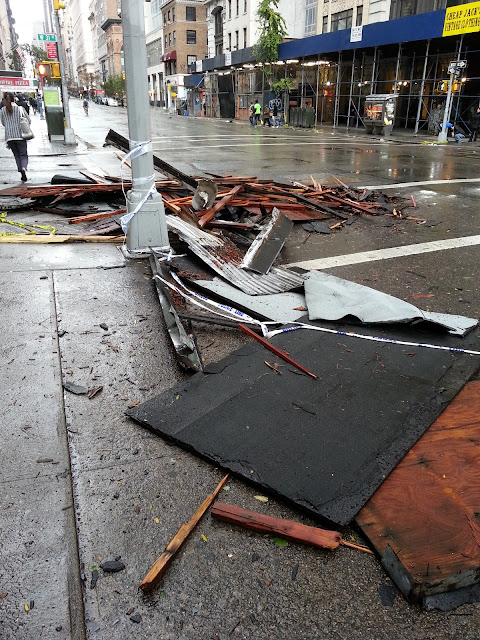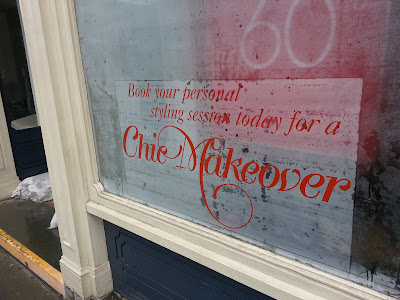The line between the powerful and powerless seems to be magicly bended around ACE, the hotel I am staying in.
Power limits in Manhattan after Hurricane #Sandy weergeven op een grotere kaart
Manhattan itself is an enclave. Public transport from and to the borough is dead, as most of the subway tunnels are filled with ocean water. The major access roads to Manhattan - above and under water - are closed. The city is incredibly quiet. Its residents are helpless ans inconsolable.
Midtown barely shows any visible damage. Here and there a traffic light has collapsed and on 5th Avenue, about two blocks are blocked because the scaffolding on top of a 30 story building has come down.
I am not the only one taking pictures, to say the least. New York has become a city of spectators. They fill the now empty streets of midtown.
Descending Broadway on my bike, the seriousness of the situation gets clearer with every mile I ride.
Everything that wind or water could take, has landed somewhere else. Chunks of waste flock together against the buildings. No shop is open, not a coffee bar or restaurant that can offer its guests anything. The owners of most of the affected properties are not present yet. They probably live outside Manhattan and are unable to reach their premises. Instead, people with cameras. Their targets are rather different from the normal tourists'. Today, the lenses are directed down instead of up.
Police in cars (and other car-like vehicles), police in yellow jackets on every intersection, police as guards in front of stricken buildings, police everywhere you look.
Down south, a provisional fence is supposed to keep out the curious from Battery Park, one of the hard-hit areas of Manhattan. But the fence itself has collapsed, so photographers and cameramen are swarming the park and the quays.
Camera crews are filming the park, the remnants of the ferry's departure hall, and, standing firm, the Statue of Liberty.
The departure area for the boats to the Statue of Liberty is unrecognizable. No table, no chair, no tile, nothing remained where it should be. Sandbags turned out to be as well-meant as they were useless.
The park itself is filled with fallen trees, even the playground has collapsed under one.
Shop owners near the World Trade Center have already started cleaning up. Being without electricity, they use a dustpan and brush, trying to create a little order in their small personal chaos. They realise it's futile for the moment, but still they continue, mechanically, without words.
For the merchants at South Street Seaport this is impossible. Only a day ago the shop owners had been hopeful: with sandbags on the doorstep and tape as a reinforcement of the windows, they expected to stand the storm. But the ocean came in five feet high and ruined everything. And it didn't spare Superdry Store.
The water having come that high, it's a small wonder that it disappeared that fast. But that doesn't mean that the damage is less severe. Sandy simply devastated South Street Seaport.
Mannequins afloat through the store, designer clothes packed together as large colorless bales of cotton. More pictures are taken. And where a poster lures customers for a "chic makeover", this is no longer an option for the store itself.
Two blocks further south, no mercy for a parking garage.
Near the harbor, the classical sailing ships, among them the majestic Peking, seem to have survived. Flags and road signs haven't. No parking!
As the convoy of ConEdison cars is welcomed by a group of photojournalists, I try to follow the East River bikepath north.
Trees are all around the place, there is not much left of the small park at the East River Promenade.
 |
| Sandy didn't watch the signs |
Large parts of FDR Drive, the six lane highway alongside East River, are still under water. Where the ocean has withdrawn, walkers and bikers are allowed on the road. They take this rare opportunity.
I ride back to midtown, where the wind is far less than at the coastline and where damage is far from everywhere. On Times Square, many stores have already reopened and tourists are searching for the nicest souvenirs as if nothing happened last night.
57th street is still a no go area because a crane on top of a brand new skyscraper has collapsed halfway and might fall down.
Ten blocks down on 5th Avenue, the manager of the affected building I saw this morning, is filming his own havoc. Sometimes spectators are also victims.
As the night falls, 5th Avenue is still a dark place. As is everything south of 40th street.
First post in this series: Preface
Second post: Ignorance
Third post: Anxiety
Fourth post: Helplessness (this post)
Fifth post: Epilogue
To watch all of my 300+ photos and videos, click here.
(PS: today I also find time to take on an old handcraft: writing a story for the Telegraaf newspaper, and being a correspondent for two Dutch radio stations. Thanks colleagues, that was fun...)


































Brian Cullman, mentioned in post 2, just wrote me this wonderful related story. He agreed to share it here. I'm very happy to do so.
BeantwoordenVerwijderenPLAN B
A young Mitt Romney type in J Crew stood on the corner of Christopher & Hudson, thermos in hand, offering passers-by cups of coffee, two dollars a cup. People just gave him looks.
Mostly, people were neighborly. Hudson Bagels handed out day old bagels. Garber's Hardware, who had a generator, put out power strips for people to charge their phones and offered Pepperidge Farm cookies & coffee (no $2 donation required).
People shared candles and batteries and food and offered neighbors hot showers (no, not in THAT way. Although...well, maybe).
Calvin Trillin was seen wheeling his bike up the street looking for a copy of The Times on his way up to The New Yorker. "I don't think of it as a magazine. I think of it as a filling station. It's up on Times Square, they've got all the electricity you can eat!"
Local animals sensibly stayed out of harm's way, but not all their owners were so lucky, and a nearby vet quietly examined pet owners who couldn't get to a doctor but who'd broken a toe or taken a spill in the darkness.
At Buvette, on Grove & Bleecker St, the owner was cooking up whatever was in the fridge and freezer, laying out trays of croque monsieurs and cheese and apples and fresh tart tatin for anyone in the neighborhood. But wines, good wines not likely to go bad because of a power out, were opened with cheerful abandon and poured for anyone who ambled by.
The Gigondas was described by one of the staff as tasting like plums and bedroom slippers, while the Chambertin was reckoned to be more like an early David Foster Wallace story, very complex, a lot going on, but no resolution.
That seemed a pretty fair description of the long, chilly days with no power and no news, only rumors and candles and dark.
Meanwhile Jody at Buvette kept pouring Medoc and Cahors, Burgundy and Beaujolais.
" That's why I got into this in the first place. To feed people. To offer a sense of community and warmth."
And maybe make some money, I ventured, watching another $60 bottle of wine being emptied into a stranger's glass.
"Well, that was Plan A. I've had to move over to Plan B."
--- Brian Cullman